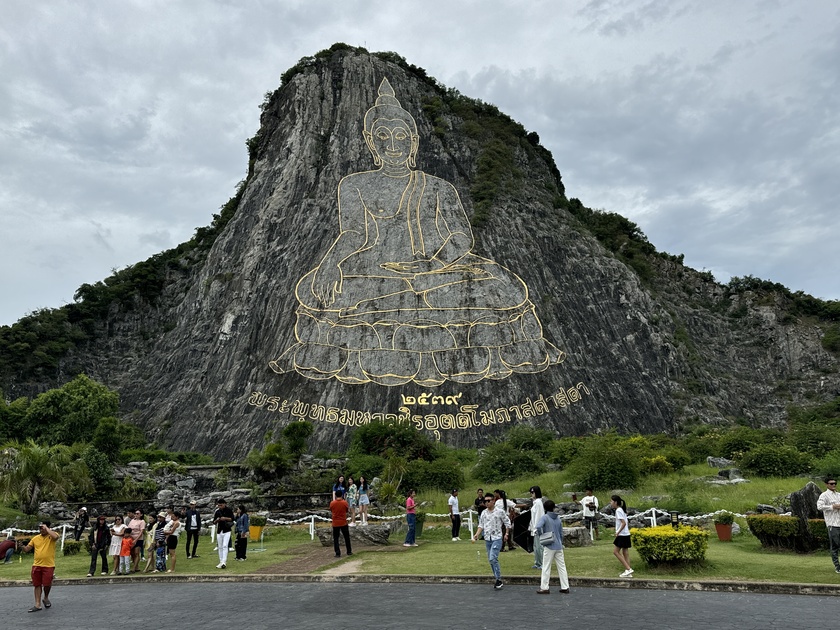Khao Chi Chan, or as it is more commonly known, Buddha Mountain has become an iconic landmark in Pattaya and a popular tourist attraction. This giant golden Buddha carved into the face of a mountain cliff is set among a beautiful and tranquil park.
A short walk along paved paths will bring you right to the base of the mountain where you can see the full detail and really appreciate the gigantic scale of this impressive carving. There is a small lake at the foot of the mountain filled with lilies and lotus flowers.
There is no entrance fee at Khao Chi Chan, however, there are several donation boxes around where you can make a small offering to help with the upkeep of this lovely sight.
The mountain was originally mined for U.S. Army and Air Force projects at the local Utapao Airport during the Vietnam War. The mining continued on for several years after the Americans departed, eventually leaving the sheer face of the mountain we see today.
In 1995 the idea to carve a giant Buddha on the ...
The Chang FA Cup, officially the Thai FA Cup, is Thailand’s premier knockout football competition, organized by the Football Association of Thailand. First held in 1974, it ran intermittently until 1999 before being discontinued and relaunched in 2009 to revive national cup football. Sponsored by Chang Beer since 2015, it has become known as the Chang FA Cup. The tournament is open to clubs from all levels of Thai football, offering lower-division teams a chance to upset top-tier sides. The winner qualifies for the AFC Champions League Elite qualifying play-off and the Thailand Champions Cup, with the champion receiving a prize of 5 million baht.
Port FC, based in Bangkok, is a historic club founded in 1967, originally linked to the Port Authority of Thailand. They play their home games at PAT Stadium. Port has established itself as a consistent force in the Thai League 1 since returning to the top flight in 2017, with strong performances in recent seasons, including qualification for ...
Dragon Town Night Market
Dragon Town Night Market, also known as the vibrant Chula Night Market (or Sam Yan Market) near Chulalongkorn University, is a lively central spot that bursts into life after dark. This compact, student-favored area features rows of glowing stalls offering authentic Thai street food like spicy noodles, grilled meats, fresh seafood, and creamy desserts. The atmosphere blends traditional flavors with a youthful energy—think colorful lights, aromatic street eats, and a mix of locals and visitors. It’s a great showcase of Bangkok’s casual, university-driven food culture, with everything from classic som tam to innovative fusion bites.
Joy Fest Night Market
Joy Fest Night Market is a festive pop-up night market running through late December 2025, with stalls set up until December 30. This holiday-themed event focuses on joyful vibes with a wide array of street food vendors serving seasonal treats, international snacks, and classic Thai dishes. Expect a warm, celebratory ...
Wat Na Tang Nok (Thai: วัดหน้าต่างนอก, also spelled Wat Natang Nok or Wat Na Tang Nork) is a historic Buddhist temple affiliated with the Mahanikay sect, located in Bang Sai District, Phra Nakhon Si Ayutthaya Province, Thailand. It’s situated in the rural area near Ban Na Mai, surrounded by fields and canals, giving it a peaceful, traditional atmosphere away from the main tourist crowds in central Ayutthaya.
The temple is best known for its association with Luang Pho Jong (Phra Athikan Jong Buddhāsaro), a highly revered monk who served as abbot here. Born in 1872 AD and passing in 1965 AD, Luang Pho Jong was one of Ayutthaya’s most respected masters during the early to mid-20th century. He was renowned for his meditative prowess, protective amulets (especially during the Indochina War era), and sacred objects like wealth-attracting fish motifs. Collectors still seek his amulets today for blessings of protection, wealth, and charisma.
The temple itself features ...
















































